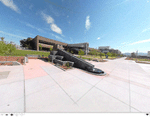NEWS RELEASES
FOR IMMEDIATE RELEASE
August 23, 2007
DOE/NNSA dedicates half-billion-dollar microsystems engineering sciences complex at Sandia
Technologies to include radiation resilient electronics for national security
ALBUQUERQUE, N.M. —The U.S. Department of Energy Deputy Secretary Clay Sell, National Nuclear Security Administration (NNSA) Administrator Tom D'Agostino, Senator Pete Domenici, and Sandia President Tom Hunter today celebrated completion of the Microsystems and Engineering Sciences Applications (MESA) Complex at Sandia National Laboratories, completing NNSA’s eight-year, $516 million project.
This project is the largest in the history of the lab and was completed three years ahead of schedule and $40 million below budget.
Beyond its security role, the complex’s combination of high-performance computing simulations, scientific research, and production capabilities in electronics and optics at the micro- and nano-level will make it a world leader in a new type of simulation-led engineering that will ultimately improve the quality of consumer goods.
In security work, the MESA complex will produce electronic circuits and computer chips designed to withstand high levels of radiation. These “hardened” electronics are critical to national security needs.
The 400,000-square foot MESA complex consists of a Microfabrication Facility, a Microsystems Laboratory, and a new Weapons Integration Facility, which will contain laser, electrical, visualization, and computer laboratories as well as office workspace for more than 600 scientists and engineers. To an unprecedented degree, it will combine electronic and optoelctronics fabrication facilities with Sandia’s supercomputing simulations.
“In opening the MESA complex at Sandia National Laboratories, we are increasing our nonproliferation capabilities and applying next-generation microelectronics technology to advancing our national security,” Sell said. “From maintaining our nuclear stockpile to realizing scientific breakthroughs, the employees of Sandia National Laboratories are applying the best science and engineering to some of our nation’s most vital and sensitive national security, environmental and energy challenges.”
“The MESA complex provides NNSA with a capability you can’t find anywhere else,” said D'Agostino. “With the technology developed here, anything from our country’s nuclear weapons to communications satellites will be able to withstand the worst of conditions.”
“The MESA project is a cornerstone in the foundation of the nation’s science and engineering future,” said Tom Hunter, Sandia President and Labs Director. “It uniquely provides a design environment and combines the power of the world’s most powerful computers with the development of small, smart things (microsystems) that are integrated into applications of unlimited potential. There is no other place like it. We are proud the nation chose Sandia as the place for this investment. We are equally proud to complete the project on time and on budget. This is a defining achievement for Sandia.”
A seven-foot tall brass statue of Willis Whitfield, who solved a major problem in making modern microelectronics production possible, was unveiled during the ribbon-cutting ceremony. Whitfield is a retired Sandia employee who discovered how to remove particles of dust from silicon fabrication facilities, a problem that caused an almost 50 percent failure rate in some industries. The statue was designed and sculpted by former Sandia employee Neal McKuen and is a tribute to all engineers.
Sandia is a multiprogram laboratory operated by Sandia Corporation, a Lockheed Martin company, for the U.S. Department of Energy’s National Nuclear Security Administration. With main facilities in Albuquerque, N.M., and Livermore, Calif., Sandia has major R&D responsibilities in national security, energy and environmental technologies, and economic competitiveness.
Sandia news media contact: Neal Singer, nsinger@sandia.gov, (505) 845-7078
